Camponotus (Myrmotrema) olivieri Forel
  Type location Angola
(Camponotus foraminosus Forel race C. Olivieri n. stirps., Forel,
1886f: 175, major & minor workers & queen - see below; raised
to species Dalla Torre,
1893: 246). Type location Angola
(Camponotus foraminosus Forel race C. Olivieri n. stirps., Forel,
1886f: 175, major & minor workers & queen - see below; raised
to species Dalla Torre,
1893: 246). 
|
subspecies
concordius (Santschi, 1915c: 272, major & minor
workers) from Angola - see below
lemma (Camponotus
foraminosus Forel race C. lemma n. stirps, Forel, 1886f:
176, worker & queen; variety of olivieri
in Sanstchi, 1915c: 270) from Angola, Benguela, Cocoba, Cruchet
- see http://www.antweb.org/specimenImages.do?code=casent0910486
delagoensis (Camponotus
foraminosus Forel race C. delagoensis n. stirps., Forel,
1894b: 68, major & minor workers; variety of olivieri in Sanstchi, 1915c: 270)
from Mozambique - see below
freyeri (Forel, 1912k: 166; Santschi, 1915c: 270,
worker; stirps of olivieri in
Santschi, 1915c: 270) from Aldabra I.,
Seychelles - see http://www.antweb.org/specimenImages.do?code=casent0910489
infelix (Camponotus
(Myrmotrema foraminosus For. r. lemma For. v. infelix n. var., Forel, 1914d: 254;
stirps of olivieri in
Santschi, 1915c: 270, major & minor workers) from South Africa,
Durban, Natal, G Arnold - see http://www.antweb.org/specimenImages.do?code=casent0910491.
tenuipilis (C. foraminosus forel, sous-esp. Olivieri
Forel, var. tenuipilis, Emery, 1895h: 54, worker; Santschi,
1915c: 270, in key, worker) from South Africa - see below.
moshianus (Camponotus
foraminosus Forel subspecies lemma
Forel var. Moshiana n. var.,
Forel, 1907a: 31; Santschi, 1915c: 270, worker)
from Tanzania - no images available
nitidior (Camponotus
(Myrmotrema) olivieri Forel var. nitidior n. var., Santschi, 1926c:
617, worker) from Zaïre - see http://www.antweb.org/specimenImages.do?code=casent0910483
osiris (Camponotus
carbo Em. subsp. Osiris
n. subsp., Forel, 1911f: 281, worker) from Zaïre, collected at
Congo da Lemba, by R. Mayné - see http://www.antweb.org/specimenImages.do?code=casent0910493
sorptus (Camponotus
foraminosus Forel subsp delagoensis
Forel var. sorpta
n. var., Forel,1909b: 62, and Santschi, 1915c: 270, major & minor
workers
& queen) from Zaïre - see http://www.antweb.org/specimenImages.do?code=casent0910487
patersoni (Arnold, 1959: 337, illustrated, major
& minor workers) from Botswana - no images available.
pax (as a variety of the stirps tauricollis
Santschi, 1915c: 273; Menozzi, 1942c:
180, major & minor workers) from Cameroun - see http://www.antweb.org/specimenImages.do?code=casent0911845
unavailable name fricatus
(Camponotus (Myrmotrema) tauricolis stirps osiris Forel
var. fricatus n. var.,
Santschi, 1926c: 616, worker; the label has "Camponotus (Myrmentoma) osiris For.
v. fricatus Sants.") from Zaïre
- see http://www.antweb.org/specimenImages.do?code=casent0911844
. |
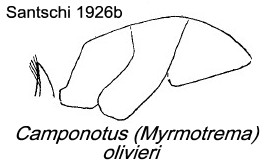 Forel's
(1886f) description is at Forel's
(1886f) description is at  , it is compared with the type foraminosus.
Forel's (1886f) description of lemma is at , it is compared with the type foraminosus.
Forel's (1886f) description of lemma is at  . Emery (1895h) stated tenuipilis
differed from the type olivieri by having finer erect hairs on
the gaster, no thicker if not thinner than the pubescence, which also
was whiter than on the type. Forel (1907a) described moshiana
minor as being somewhat small than the type, with the propodeum dorsum
a little longer. Forel (1911f) described osiris, media and
minor only, TL 4.2-6.5 mm, similar to puberulus but gaster
shiny and feebly shagreened. Forel's (1894b) description of delagoensis
is at . Emery (1895h) stated tenuipilis
differed from the type olivieri by having finer erect hairs on
the gaster, no thicker if not thinner than the pubescence, which also
was whiter than on the type. Forel (1907a) described moshiana
minor as being somewhat small than the type, with the propodeum dorsum
a little longer. Forel (1911f) described osiris, media and
minor only, TL 4.2-6.5 mm, similar to puberulus but gaster
shiny and feebly shagreened. Forel's (1894b) description of delagoensis
is at  , Forel's (1909b)
description of sorpta
is at , Forel's (1909b)
description of sorpta
is at  . Forel's (1912k)
description of freyeri is at . Forel's (1912k)
description of freyeri is at  , Forel's (1914d)
description of infelix is at , Forel's (1914d)
description of infelix is at  , Santschi's (1915c)
descriptions of concordia and pax are at , Santschi's (1915c)
descriptions of concordia and pax are at  . Santschi's (1926c)
description of fricatus & nitidior is at . Santschi's (1926c)
description of fricatus & nitidior is at  , Arnold's (1959)
description of patersoni is at , Arnold's (1959)
description of patersoni is at  . .
|
Note the Antweb images (posted April-May 2014)
show that many if not all the above forms are no more than size
variations. The type form, for instance, appears to have been described
from media and minor workers. The concordius form has a larger
major worker (shown below). The delagoensis
workers shown below have the minor appearing to exactly match the type
minor and the major to match the concordius
major.
Distinct, however are, fricatus which may well
be as Santschi
originally had it under tauricollis with thick white erect
hairs (unlike the fine yellowish hairs on olivieri); this
is the case
also for infelix and the
red-brown freyeri.
|
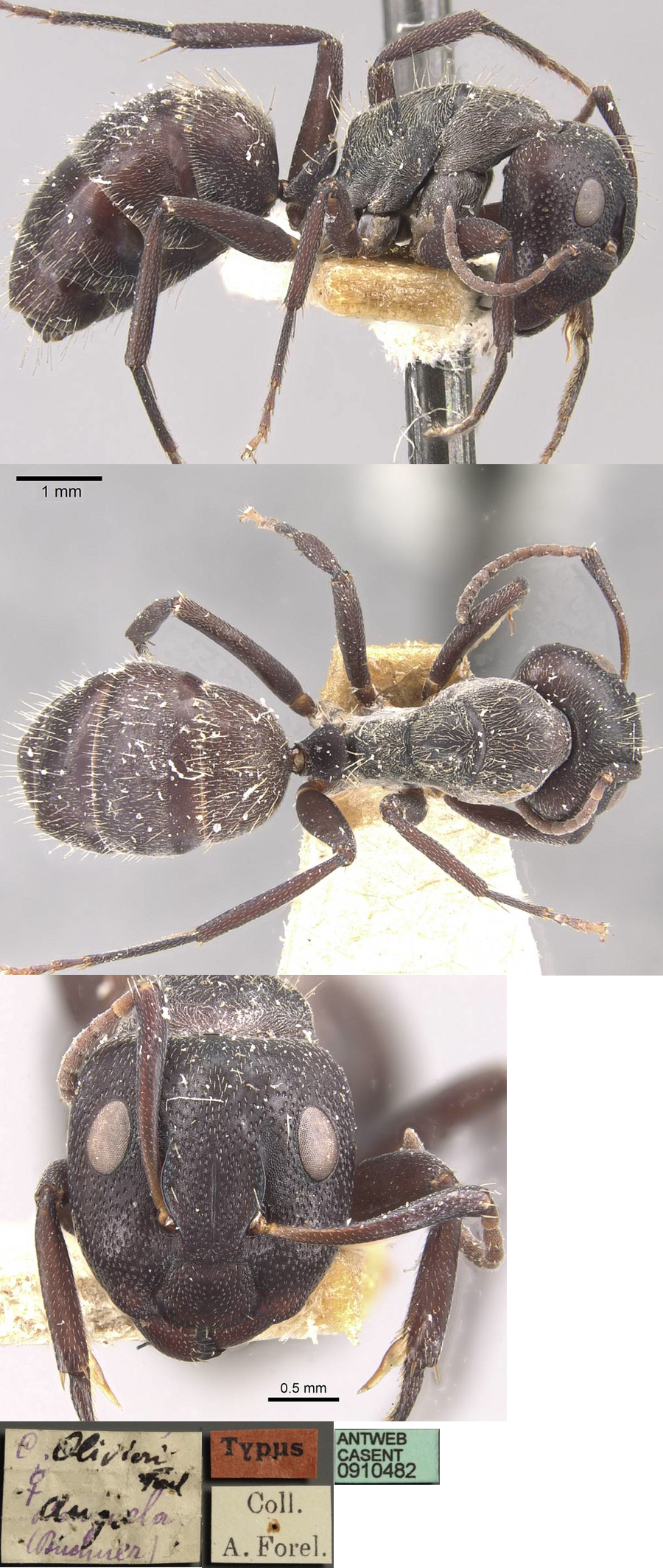 The photomontage of a
type major (probably media) worker
is collated from http://www.antweb.org/specimen.do?name=casent0910482. The photomontage of a
type major (probably media) worker
is collated from http://www.antweb.org/specimen.do?name=casent0910482.
|
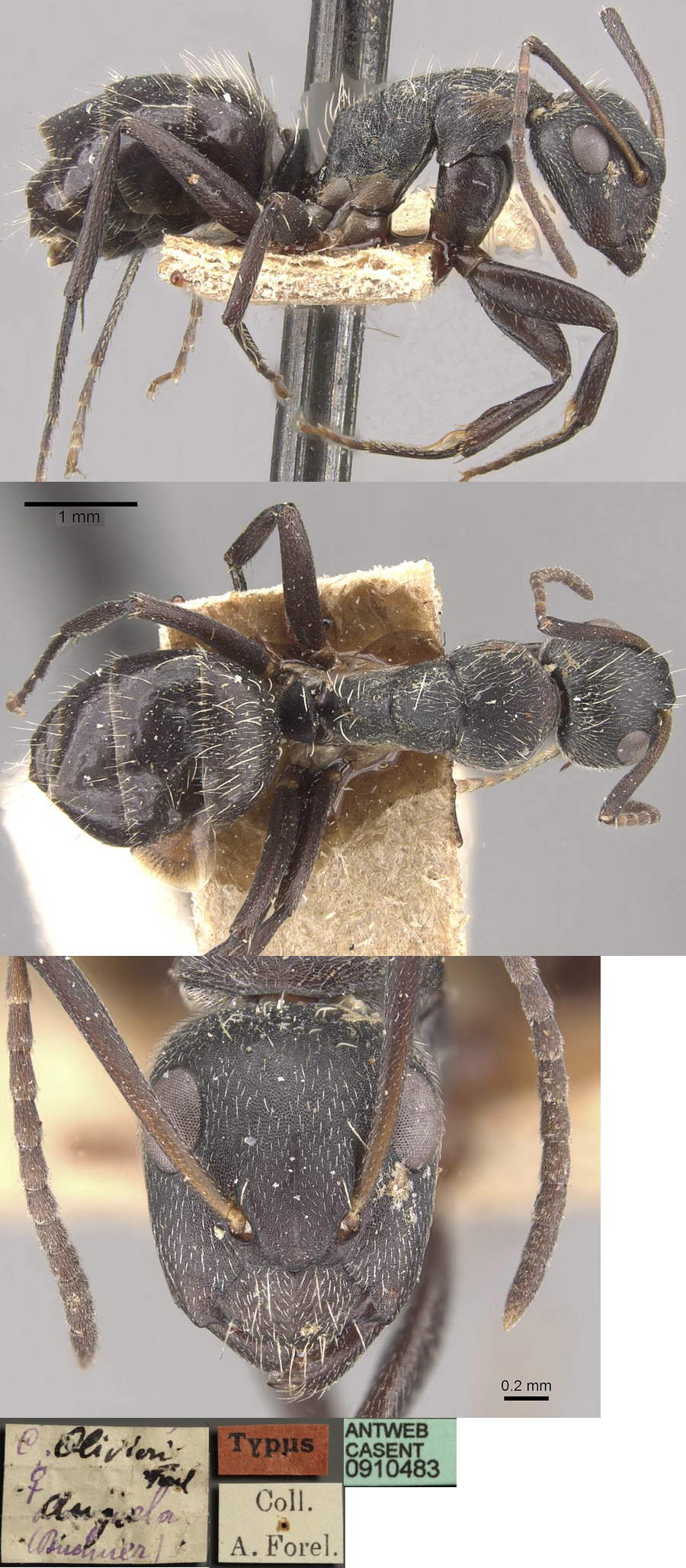 The photomontage of a
type minor worker
is collated from http://www.antweb.org/specimen.do?name=casent0910483. The photomontage of a
type minor worker
is collated from http://www.antweb.org/specimen.do?name=casent0910483.
|
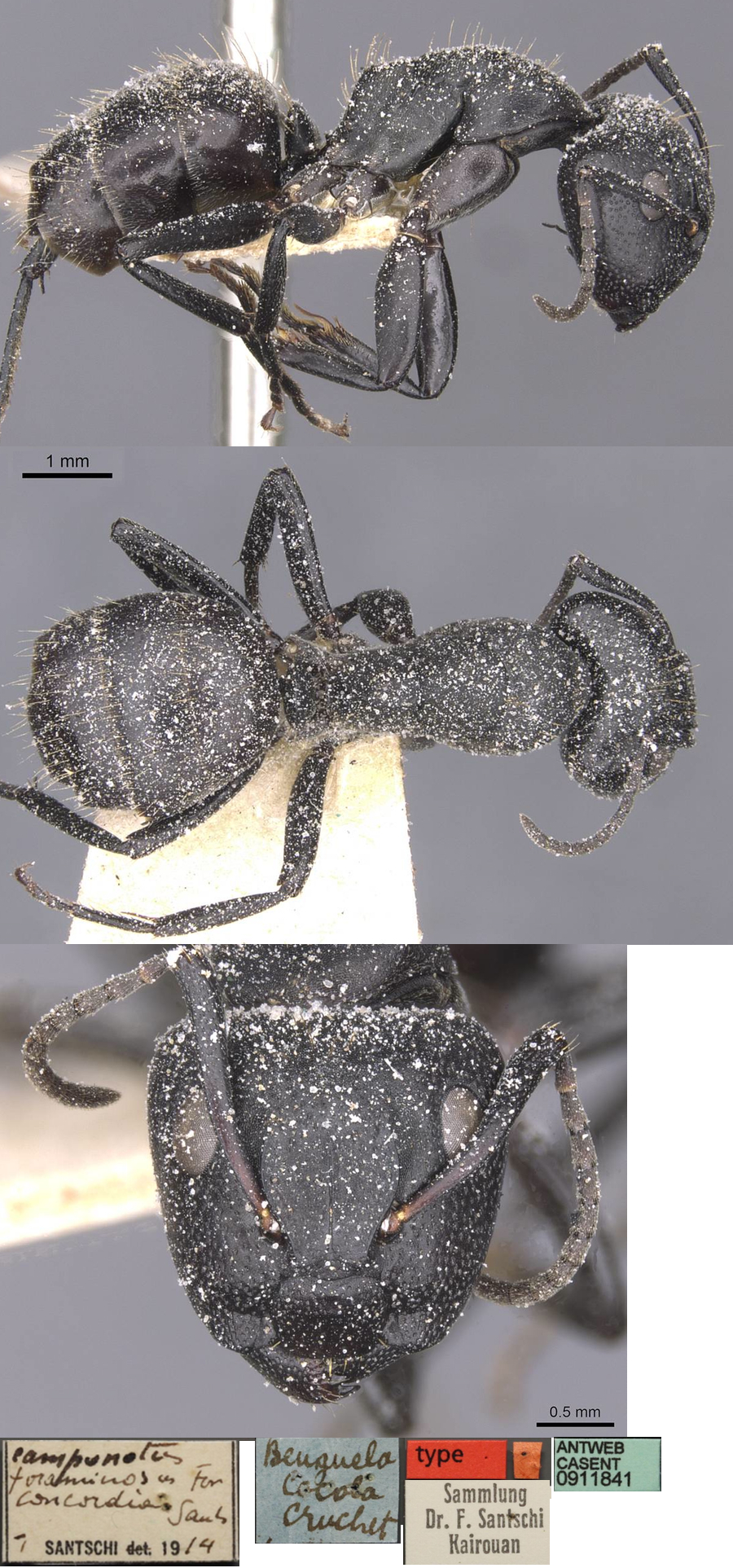 The
photomontage of a concordius major
worker
is collated from http://www.antweb.org/specimen.do?name=casent0911841. The
photomontage of a concordius major
worker
is collated from http://www.antweb.org/specimen.do?name=casent0911841.
|
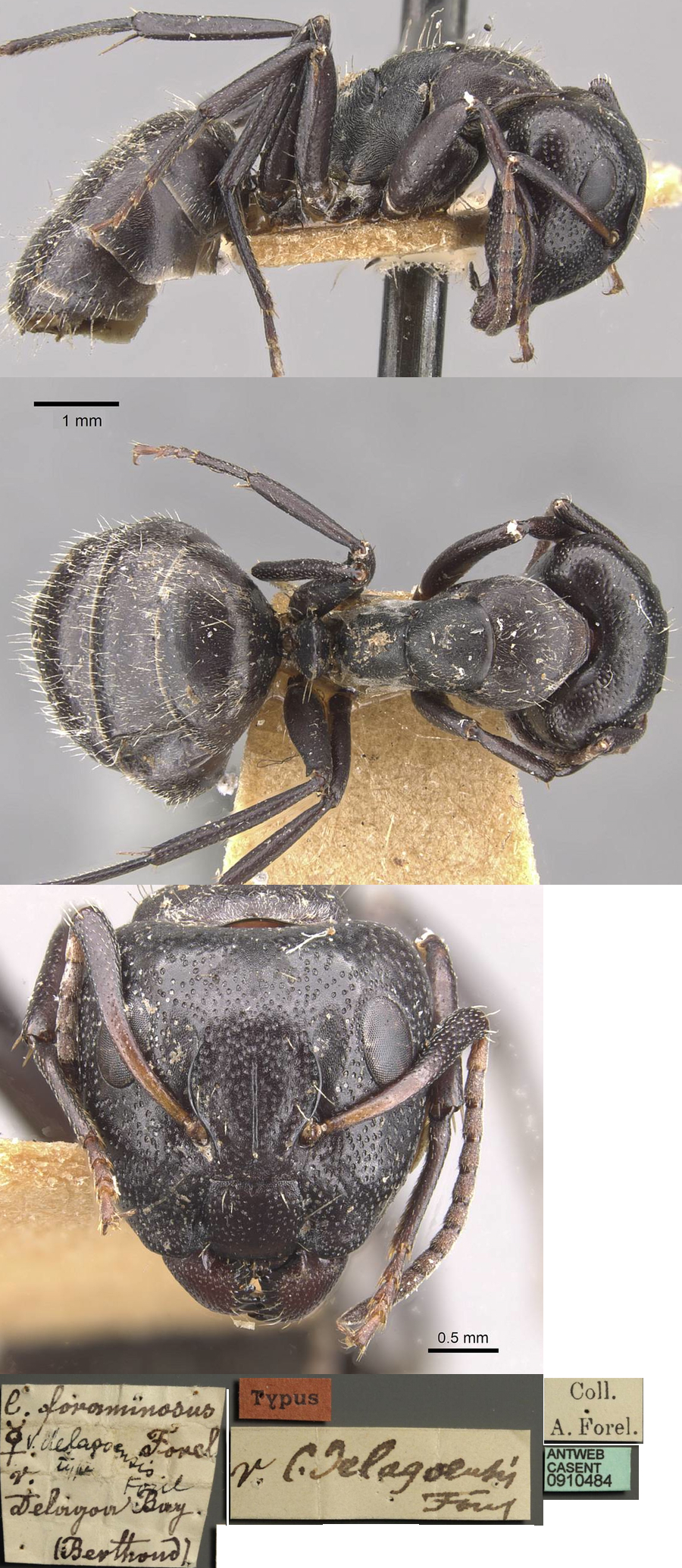 The
photomontage of a delagoensis major
worker
is collated from http://www.antweb.org/specimen.do?name=casent0910484. The
photomontage of a delagoensis major
worker
is collated from http://www.antweb.org/specimen.do?name=casent0910484.
|
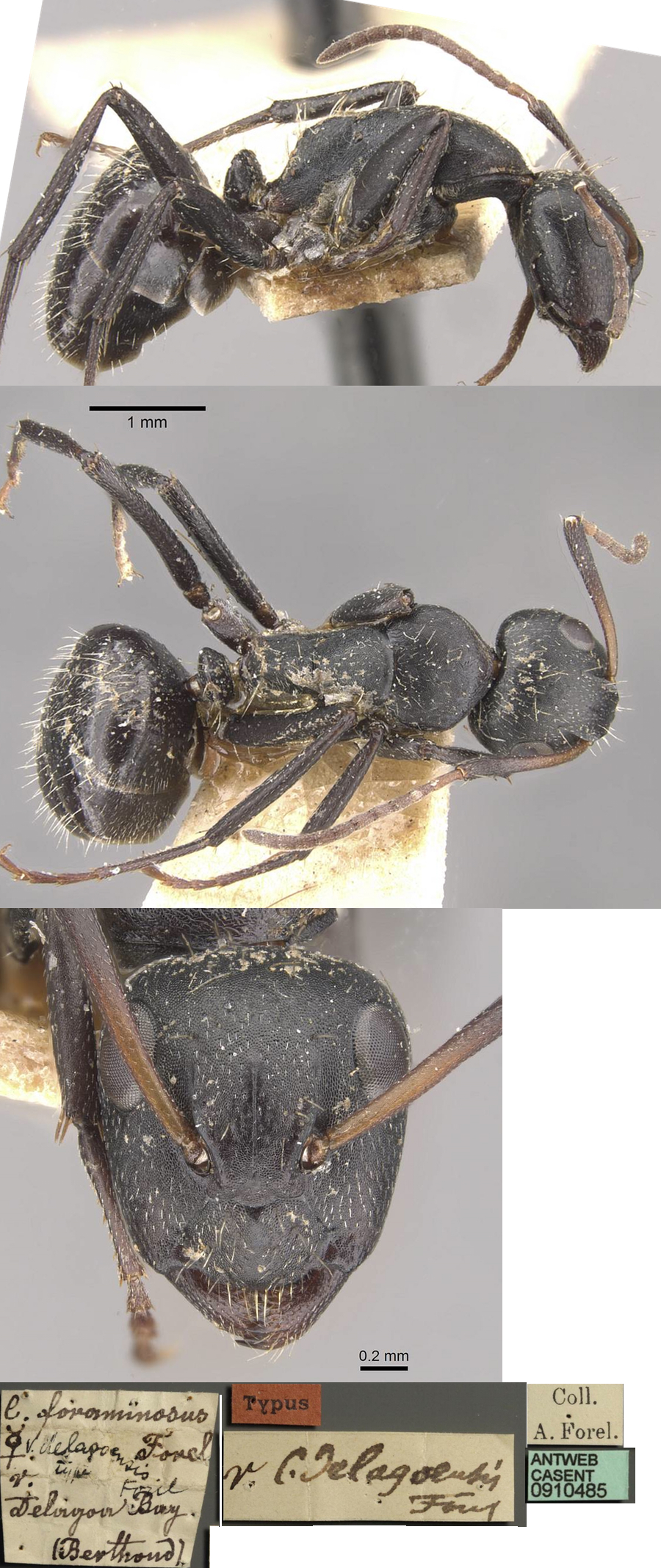 The
photomontage of a delagoensis minor
worker
is collated from http://www.antweb.org/specimen.do?name=0910485.
Appears identical to the type minor. The
photomontage of a delagoensis minor
worker
is collated from http://www.antweb.org/specimen.do?name=0910485.
Appears identical to the type minor.
|
Oxford University Museum
specimens
Camponotus (Myrmotrema) olivieri
B Taylor det.
|
Sudan
Awatif Omer
2013.02.09
|
2013
Abu Hijar
12˚52' N
34˚0' E
|
minor worker
|
1
|
 |
Camponotus (Myrmotrema) olivieri
B Taylor det.
|
Sudan
Awatif Omer
2013.02.16
|
2013
Sinja
13˚09' N
33˚55'60" E
|
minor worker
|
1
|
 |
Camponotus (Myrmotrema) olivieri
B Taylor det. |
Ivory Coast
Erena Dupont
iii.2014
|
Taï National Park
5˚45'00" N
7˚07'00" W
|
19
minor
|
1
|
 |
Camponotus (Myrmotrema) olivieri
B Taylor det.
|
Cameroun
A Fotso Kuate
Camponotus sp8
|
18.ix.2007
Awae II
03°54'30" N
11°25'58" E
|
Quadrat in forest
|
2
|
 |
Camponotus (Myrmotrema) olivieri
B Taylor det. |
Congo
E Zassi
12-t-2-1
n sp 11
|
8-9.xi.2007
Lésio-Louna
03°16'21.7" S
015°28'12.5" E
|
Gallery Forest; 24h
pitfall trap
|
1
|
 |
Camponotus (Myrmotrema) olivieri
B Taylor det. |
Gabon
Y Braet
Gabon 120
|
7-8.viii.2006
Pongara
00°34' N
09°19' E
|
Sesame & forest,
sweep net
|
1
|
 |
Camponotus (Myrmotrema) olivieri
B Taylor det. |
Gabon
Y Braet
Gabon 203
|
17.v-09.vi.2006
Pongara
00°34' N
09°19' E
|
Savannah, malaise
trap
|
|
 |
|
 The
photomontage is of a media worker from Cameroun, Awae II;
collector.
Fotso Kuate (Camponotus sp8). The
photomontage is of a media worker from Cameroun, Awae II;
collector.
Fotso Kuate (Camponotus sp8).
|
 The
photomontage is of a minor from Cameroun, Awae II, as above. The
photomontage is of a minor from Cameroun, Awae II, as above.
|
 The
photomontage is of a specimen from Congo, Réserve de
Lésio-Louna; collector Eric Zassi. The
photomontage is of a specimen from Congo, Réserve de
Lésio-Louna; collector Eric Zassi.
|
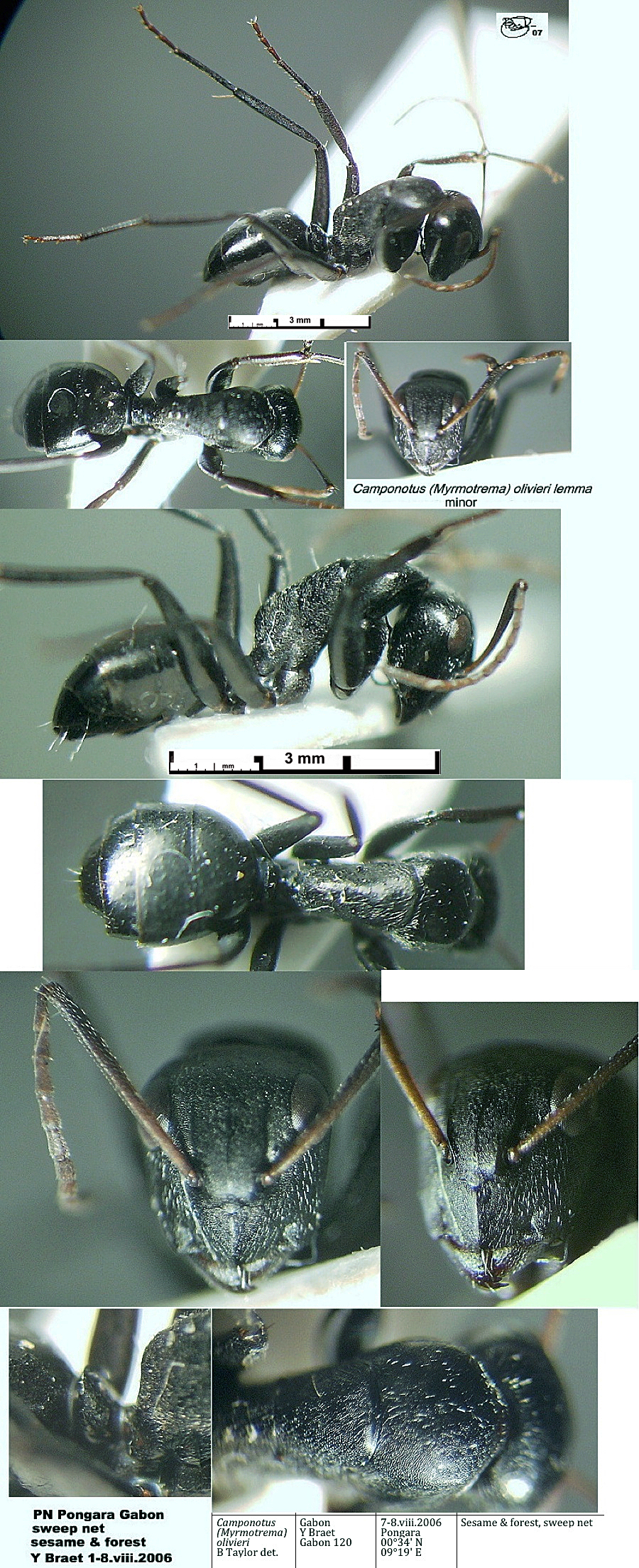 The photomontage is of
a minor worker, appearing to
match the Forel description of the lemma minor, from Gabon,
Pongara National Park; collector Yves Braet (Gabon 120). The photomontage is of
a minor worker, appearing to
match the Forel description of the lemma minor, from Gabon,
Pongara National Park; collector Yves Braet (Gabon 120).
It is very distinctly less pilose than the type form, with a narrower,
higher propodeum, with a narrow dorsum, also somewhat shinier. |
The illustrations of minor faces (below left) are from
Santschi (1935), who recorded osiris from Congo da Lemba, by R.
Mayné, i.1913, and Mongende, by Dr Schouteden, 19.iv.1921. Santschi
noted that it differed from olivieri by the minor having
slightly larger eyes, and the head narrower. The erect hairs on the
gaster were shorter and less abundant; and the pubescence variably
yellow and white.
Emery (1895h) separated tenuipilis as having
finer erect hairs on the gaster, plus whiter pubescence. Forel's
(1911f) description of osiris (as a subspecies of Camponotus carbo)
was minor and media, TL 4.2-6.5 mm; overall similar to ssp puberulus
[later raised to species by Santschi, 1915c] but the
gaster is shiny and feebly shagreened. The pubescence is paler and
yellowish. He regarded it as a simple variety but noted typical carbo
and ssp puberulus are profoundly matte, and the shiny gaster of
osiris was very contrasting. Specimens from Zaïre,
Congo da Lemba by Mayné.
|
 The photomontage of delagoensis is derived from
those taken and identified by Mike Lush at http://sifolinia.blogspot.com/2008/01/camponotus-olivieri.html. The photomontage of delagoensis is derived from
those taken and identified by Mike Lush at http://sifolinia.blogspot.com/2008/01/camponotus-olivieri.html.
Forel (1909b) described delagoensis var sorpta
-
TL 5-9 mm; less robust than delagoensis, sides of head less
convex; propodeum dorsum shorter and more convex, shorter than
declivity. Petiole scale as biconvex, but less slim and with a sharper
dorsal border. Otherwise the same form. More matte, sculpturation
deeper, reticulate or shagreened; gaster less shiny. Fossae on head
identical, as strong and as abundant. Pilosity longer, whiter, more
setiform and more like olivieri. Greyish pubescence abundant as
the delagoense type and even more than olivieri;
forming a thin but very clear grey blanket, over all the thorax and
gaster. Colour as typical delagoense. Overall differs from olivieri
by being longer and with the head more enlarged behind and narrowed
anteriorly; and a more depressed pronotum.
Forel also described the female and male. Specimens from the stomach of
a Pangolin in Bas Congo, collected by Solon.
|
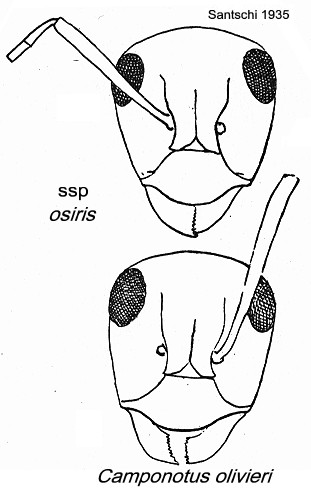 My translation of pax is - My translation of pax is -
TL 4.5-6.5 mm; Largest morphs with scapes surpassing occiput by
one-fifth their length. Thorax slightly convex. Propodeum with
well-defined angle; dorsum as in type, quite slim, and as long as the
declivity. Colour black, lower legs and antennae brown. Pubescence
fairly long, fine and white as in type; in minors pubescence on genae
and clypeus longer than type. Head and thorax very matt, except for the
genae of the largest morphs. Gaster strongly reticulate and slightly
less shiny than type. In minor the head somewhat narrowed anteriorly,
sides rectilinear; pronotum very depressed and bordered in front, as in
type. Specimens from Cameroun, by Mayr (Emery label).
In Ghana, reported from CRIG by Adjei (1975),
who noted also that it is a mealybug tender. Seventeen workers were
collected by pkd from the canopy of Amelonado cocoa at CRIG by Bigger
(1981a).
|
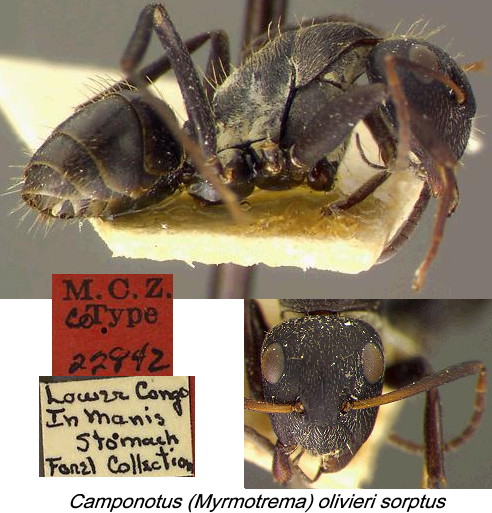 Collated photomontage is of a cotype of Camponotus
olivieri ssp sorptus (Forel, 1909b: 62, and Santschi, 1915c:
270, soldier, worker & queen) from Zaïre. The original
photographs, together with enlarged images, are from the MCZ, Harvard
University, website at - MCZ link. Collated photomontage is of a cotype of Camponotus
olivieri ssp sorptus (Forel, 1909b: 62, and Santschi, 1915c:
270, soldier, worker & queen) from Zaïre. The original
photographs, together with enlarged images, are from the MCZ, Harvard
University, website at - MCZ link.
|
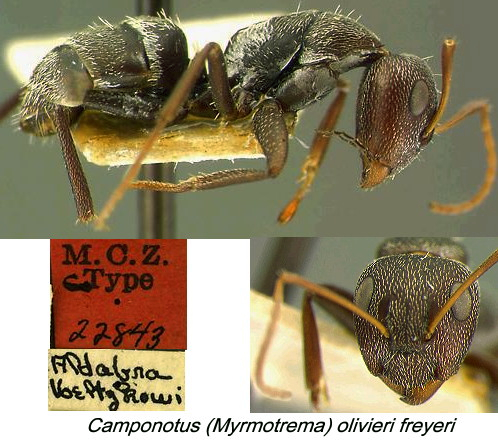 Collated illustration (right) is of a cotype of Camponotus
olivieri ssp freyeri - specimen from Aldabra Is.,
Seychelles . The original photographs, together with enlarged
images, are from the MCZ, Harvard University, website at - MCZ link. Collated illustration (right) is of a cotype of Camponotus
olivieri ssp freyeri - specimen from Aldabra Is.,
Seychelles . The original photographs, together with enlarged
images, are from the MCZ, Harvard University, website at - MCZ link.
NOTE - in Bolton (1995: 100) as freyeri from (wrongly)
Madagascar (as Camponotus foraminosus ssp aldabrensis
var freyeri Forel, 1912k: 166, worker; designated C.
olivieri st freyeri by Santschi, 1915c: 270, worker); aldabrensis
(Forel, 1897c: 203) itself now is a subspecies of foraminosus.
Forel's (1912k) description compared it with the type foraminosus
ssp aldabrensis.
It seems possible that this is a distinct species, more closely related
in form to foraminosus than to olivieri and the present
status is due to an error of judgement by Santschi (1915c) in compiling
his key. The head shape and flat eyes set further forward and within
the lateral borders of the face are notably different from the other olivieri
forms.
|
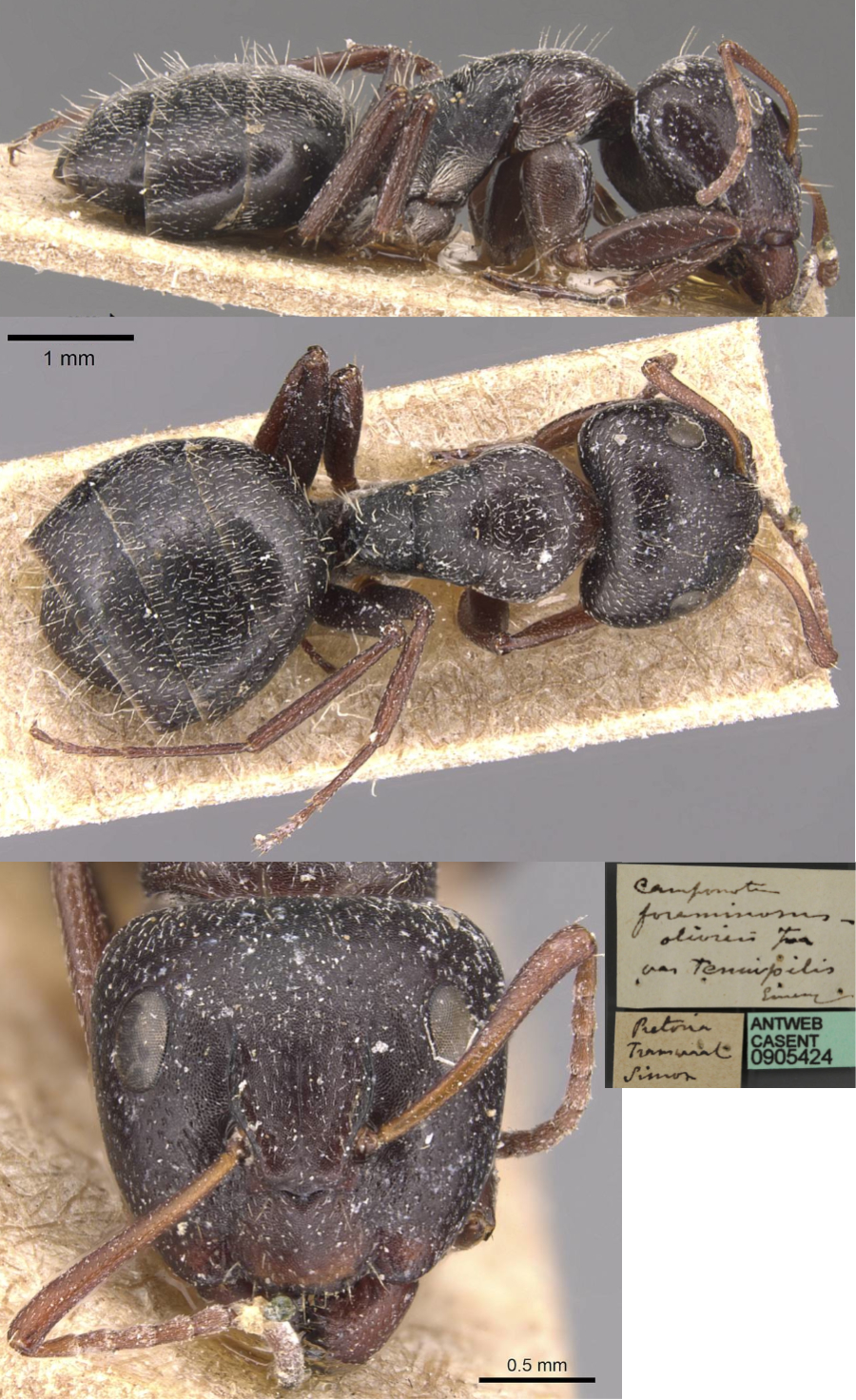 The
photomontage of tenuipilis is
collated from http://www.antweb.org/specimen.do?name=casent0905424 The
photomontage of tenuipilis is
collated from http://www.antweb.org/specimen.do?name=casent0905424
|
 The
photomontage is of a minor worker, distinct from the type
form, from Gabon,
Pongara National Park; collector Yves Braet. This is ca 85% smaller
than the type minor, has small flat eyes and short scapes, SI 95 (type
SI 121). The dense sub-erect pubescene on the hind tarsi is quite
distinctive. The
photomontage is of a minor worker, distinct from the type
form, from Gabon,
Pongara National Park; collector Yves Braet. This is ca 85% smaller
than the type minor, has small flat eyes and short scapes, SI 95 (type
SI 121). The dense sub-erect pubescene on the hind tarsi is quite
distinctive.
|
|